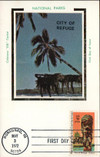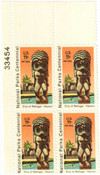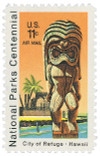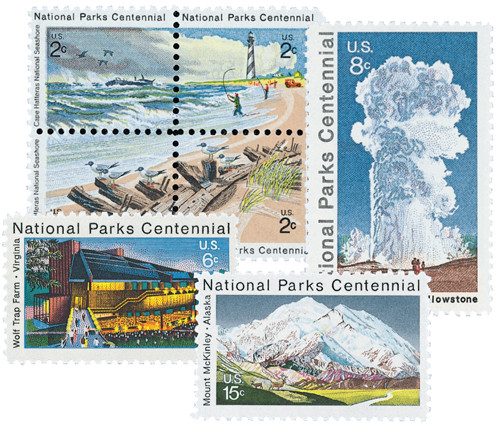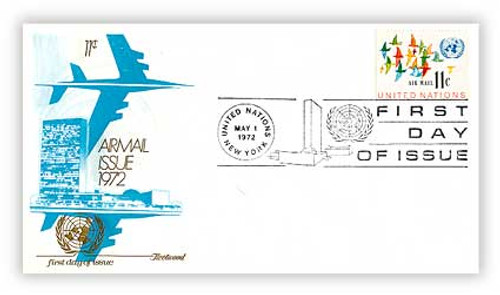
# C84 - 1972 11c National Parks
1972 11¢ National Parks
First City: Honaunau, Hawaii
Quantity Issued: 78,210,000
Printed by: Bureau of Engraving and Printing
Printing Method: Lithographed, engraved (Giori)
Perforation: 11
National Parks Centennial
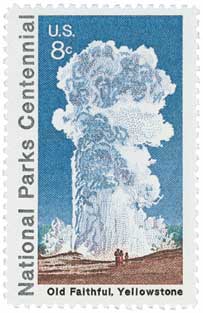
On March 1, 1972, the USPS issued the first stamp in a new series honoring the 100th anniversary of the world’s first national park. Exactly 100 years earlier, Congress established Yellowstone as a national park to protect its unusual features and resources.
These weren’t the first US stamps to honor National Parks. In 1934, President Franklin Roosevelt’s Secretary of the Interior Harold Ickes encouraged the president to approve the issue of 10 stamps featuring America’s national parks. He felt many Americans were unaware the federal government had set aside vast amounts of land for their enjoyment and for future generations. As one newspaper wrote, “It would be Federal advertising paid for many times over by philatelists.” Those stamps were also part of the Farley’s Follies, which you can read about here.
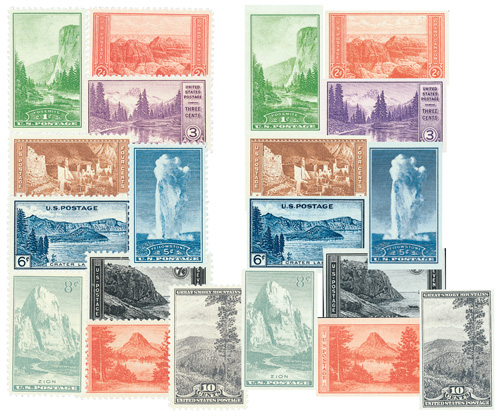
In 1972, the USPS again decided to honor our national parks on the centennial of the creation of our first national park. The National Park Service wasn’t officially created until 1916, at which point previously created parks were placed in its care.
Fittingly, the first stamp in the series featured Yellowstone and pictured the famed Old Faithful geyser. The stamp was issued on March 1, 1972, at Yellowstone National Park in Wyoming. The vast majority of Yellowstone lies in Wyoming, although it stretches into Idaho and Montana. This gigantic park covers more than 2.2 million acres, which include deep canyons, majestic waterfalls, pristine lakes, dense forests, and vast meadows. The park has more geysers and hot springs than any other area in the world. Yellowstone also has the distinction of being the largest wildlife preserve in the United States.
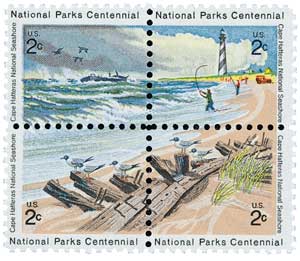
The second issue in the series was a four-stamp block picturing a scene at Cape Hatteras National Seashore. The stamps were issued on April 5, 1971, in Hatteras, North Carolina. Opened in 1953, the park contains some of the earliest sites of English colonial settlement. Located along North Carolina’s Outer Banks, the shores are home to thousands of waterfowl and have become the final stop for sections of ships that have been wrecked on the shoals.
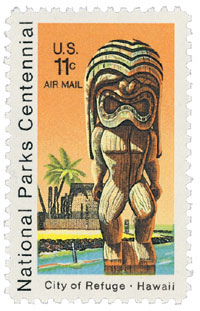
Next in the series came an 11¢ airmail stamp honoring City of Refuge, Hawaii. Established in 1961, the City of Refuge contains the platforms of three temples and the remains of dwellings of great chiefs. The stamp was issued on May 3, 1972, in Honaunau, Hawaii and pictures a “ki’i,” which is an image, statue, or likeness that serves as symbolic representation of the akua, or the multitude of Hawaiian deities and venerated ancestors. This ki’i represents the god Kane, the creator, and highest of the four major Hawaiian deities.
The fourth issue in the set featured Wolf Trap Farm and was issued on June 26, 1972, in Vienna, Virginia. Wolf Trap Farm is the only National Park dedicated exclusively to the performing arts. Wolf Trap Farm is home to various musical performances, such as the Wolf Trap Opera Company. Wolf Trap Farm became a national park in 1966 and held its first season in 1971. The scenery at Wolf Trap Farm is as impressive as the performances. The 130 rolling acres are home to a large variety of wildlife as well as an abundance of natural resources.
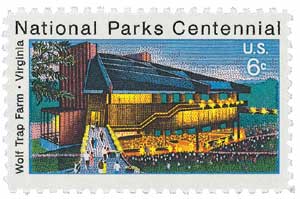
The final stamp in the series was issued on July 28, 1972 at Mt. McKinley National Park in Alaska, which was established in 1917. Mt. McKinley has the highest peak of any mountain in North America, which has earned it the nickname, “Top of the Continent.” Native Americans call the mountain Denali, which means “The Great One.” In 1980, the name of the park was changed to Denali National Park, and the mountain was officially renamed in 2015.

Click here to get the complete National Park Centennial in one convenient set.
Click here for more National Parks stamps and coins.
1972 11¢ National Parks
First City: Honaunau, Hawaii
Quantity Issued: 78,210,000
Printed by: Bureau of Engraving and Printing
Printing Method: Lithographed, engraved (Giori)
Perforation: 11
National Parks Centennial

On March 1, 1972, the USPS issued the first stamp in a new series honoring the 100th anniversary of the world’s first national park. Exactly 100 years earlier, Congress established Yellowstone as a national park to protect its unusual features and resources.
These weren’t the first US stamps to honor National Parks. In 1934, President Franklin Roosevelt’s Secretary of the Interior Harold Ickes encouraged the president to approve the issue of 10 stamps featuring America’s national parks. He felt many Americans were unaware the federal government had set aside vast amounts of land for their enjoyment and for future generations. As one newspaper wrote, “It would be Federal advertising paid for many times over by philatelists.” Those stamps were also part of the Farley’s Follies, which you can read about here.

In 1972, the USPS again decided to honor our national parks on the centennial of the creation of our first national park. The National Park Service wasn’t officially created until 1916, at which point previously created parks were placed in its care.
Fittingly, the first stamp in the series featured Yellowstone and pictured the famed Old Faithful geyser. The stamp was issued on March 1, 1972, at Yellowstone National Park in Wyoming. The vast majority of Yellowstone lies in Wyoming, although it stretches into Idaho and Montana. This gigantic park covers more than 2.2 million acres, which include deep canyons, majestic waterfalls, pristine lakes, dense forests, and vast meadows. The park has more geysers and hot springs than any other area in the world. Yellowstone also has the distinction of being the largest wildlife preserve in the United States.

The second issue in the series was a four-stamp block picturing a scene at Cape Hatteras National Seashore. The stamps were issued on April 5, 1971, in Hatteras, North Carolina. Opened in 1953, the park contains some of the earliest sites of English colonial settlement. Located along North Carolina’s Outer Banks, the shores are home to thousands of waterfowl and have become the final stop for sections of ships that have been wrecked on the shoals.

Next in the series came an 11¢ airmail stamp honoring City of Refuge, Hawaii. Established in 1961, the City of Refuge contains the platforms of three temples and the remains of dwellings of great chiefs. The stamp was issued on May 3, 1972, in Honaunau, Hawaii and pictures a “ki’i,” which is an image, statue, or likeness that serves as symbolic representation of the akua, or the multitude of Hawaiian deities and venerated ancestors. This ki’i represents the god Kane, the creator, and highest of the four major Hawaiian deities.
The fourth issue in the set featured Wolf Trap Farm and was issued on June 26, 1972, in Vienna, Virginia. Wolf Trap Farm is the only National Park dedicated exclusively to the performing arts. Wolf Trap Farm is home to various musical performances, such as the Wolf Trap Opera Company. Wolf Trap Farm became a national park in 1966 and held its first season in 1971. The scenery at Wolf Trap Farm is as impressive as the performances. The 130 rolling acres are home to a large variety of wildlife as well as an abundance of natural resources.

The final stamp in the series was issued on July 28, 1972 at Mt. McKinley National Park in Alaska, which was established in 1917. Mt. McKinley has the highest peak of any mountain in North America, which has earned it the nickname, “Top of the Continent.” Native Americans call the mountain Denali, which means “The Great One.” In 1980, the name of the park was changed to Denali National Park, and the mountain was officially renamed in 2015.

Click here to get the complete National Park Centennial in one convenient set.
Click here for more National Parks stamps and coins.



